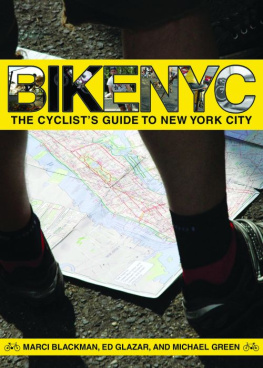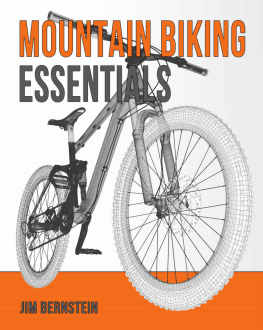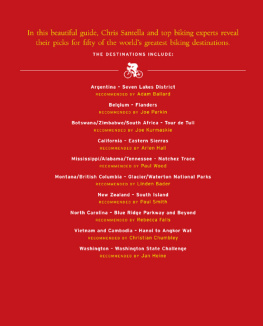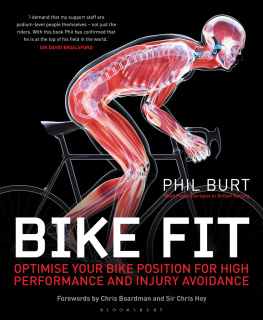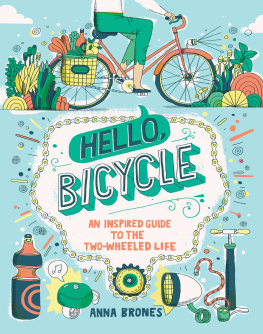
BIKE NYC
THE CYCLISTS GUIDE TO NEW YORK CITY
Marci Blackman,
Ed Glazar,
and
Michael Green

Skyhorse Publishing
Copyright 2011 by Marci Blackman, Ed Glazar, and Michael Green
All Rights Reserved. No part of this book may be reproduced in any manner without the express written consent of the publisher, except in the case of brief excerpts in critical reviews or articles. All inquiries should be addressed to Skyhorse Publishing, 307 West 36th Street, 11th Floor, New York, NY 10018.
Skyhorse Publishing books may be purchased in bulk at special discounts for sales promotion, corporate gi_s, fund-raising, or educational purposes. Special editions can also be created to speci_cations. For details, contact_the Special Sales Department, Skyhorse Publishing, 307 West 36th Street, 11th Floor, New York, NY 10018 or .
Skyhorse and Skyhorse Publishing are registered trademarks of Skyhorse Publishing, Inc., a Delaware corporation.
www.skyhorsepublishing.com
10 9 8 7 6 5 4 3 2 1
Library of Congress Cataloging-in-Publication Data is available on _le. ISBN: 978-1-61608-313-7
Printed in China
CONTENTS
INTRODUCTION
A year and a half ago, when Ed and Michael and I sat down to discuss making this book, we asked each others reasons for wanting to do so. Combined, we have logged close to two hundred thousand miles on these streets, so the answer was easy: Because the only way to see this city is by bicycle! Not just see the greatest city in the world, but as more and more riders are discovering every day, to really experience it, to breathe it, to feel its heartbeat, you have to ride it. We had plenty of other reasons too, but that was number one.
With all the new cyclists taking to the streets (over two hundred thousand to date), we thought it would be a good idea to share some of the collective knowledge that has kept us hammering all these years. To draw the curtain back, so to speak. Bike messenger lore aside, its a lot easier and safer to ride here than people think, especially with the increasing number of designated bike lanes (over two hundred miles in the last two years). You just have to be smart about it.
As tour guides we wondered, How well do those who ride really know this city? Not just the quickest routes uptown, or from Bed-Stuy to Elmhurst. On a bike it is possible to travel through ten neighborhoods on the way to your destination, more depending on where youre going. Ten distinctly different communities, some the size of small cities, countries in other parts of the world. Not underground. Not in a car, or on a bus, insulated from it all. But out in the open, through it. To be sure, most New Yorkers know at least a little something: Statue of Liberty, Empire State Building, favorite bar, the neighborhood in which they live, where they work. But what about the others? The hoods you roll through on your way? How each came into being? What went down there? Wouldnt it be cool to spin past 778 Driggs Avenue in Williamsburg and know that the real Frank Serpico was shot there? Or that the New York Life Insurance building, the one with the gilded roof on Madison and Park avenues, was the site of the first two Madison Square Gardens. As a city like no other, New York has a history all its own, and knowing it as you ride enriches the exploration tenfold.
To that end, we have mapped out some of our favorite rides through all five boroughs. Along the way, we ply you with histories, fun-filled facts and urban myths and legends about the sites and neighborhoods through which you are riding, equip you with useful on-route information including bike shop and bathroom locations, popular local eateries and quick-fix electrolyte stops. And in our On the Wheel photo profiles, we put faces to a few of the citys two hundred thousand-plus daily cyclists, some of whom have been at it even longer than we have. Part guide book, photo gallery, history, and human interest story, it is our hope that you will enjoy Bike NYC: The Cyclists Guide to New York City as much as we enjoyed creating it.
For updates, route changes, laws, and a complete listing of bike shops by borough, please check out the Bike NYC website at www.bikenycthebook.com
Ride Safe!
SAFETY TIPS:
Here are a few tips about the grid: in general, odd-numbered one-way streets run from east to west, or toward the Hudson, even numbers to the east. Fifth Avenue is the demarcation line between east and west, and to let you in a little bike messenger secret, addresses radiate outward from 5th Avenue in either direction in blocks of one hundred. In other words, 099 West 31st Street falls between 5th Avenue and Broadway, 100199 between Broadway and 6th, and so forth.
2. Avoiding the Door. Dooring is the most frequent type of collision between vehicles and cyclists in NYC. Here are some tips to avoid the door.
The city is full of livery including yellow cabs, limousines, black cars for corporate clients, and a slew of other car services. Most often drivers do not exit the vehicle but more frequently, passengers will exit from the back door on the curb side. Therefore, it is best to avoid going in between the parked car and the curb, even if it means going into the heavier flow of traffic on the other side.
Swing wide; ride approximately four feet from car doors on both sides. Bike lanes are roughly four feet in width, so if they are present, use the painted white strip on the outer part of the lane as a way of gauging distance.
Avoid parked cabs. Yellow cabs looking for a new fare will switch their lights on top to white, signaling that they are available. Parked cabs with their lights off indicate that there are passengers still inside and could pop out at any second. If possible try and gauge how many passengers are in the car and whether the street side of the cab is also a danger.
You can use side mirrors of vehicles to determine if there are occupants in the vehicle. You can also look for signs such as brake lights on or, in the winter, car exhaust identifying that the vehicle has an occupant.
Assume nothing. Cyclists can get doored in the middle of the street from cab drivers with no passengers dumping out their cold coffee or when passengers decide there is too much traffic and want to get out. Be aware, and try as much as possible to give yourself distance from all motor vehicles.
3. Salmoning. Popular satirical blogger the Bike Snob (www.bikesnobnyc.blogspot.com) coined the phrase salmoning for people going the wrong way down a one-way street. Dont be a fish.
4. Intersections. Intersections are the most common place where accidents occur. Be super aware of your actions and motorists when navigating them. Do not assume motorists will signal when making turns or are aware of your presence. For example, if you are in the left-turn lane of a busy intersection, ride to the right of the vehicles and the lane, which may mean exiting a left-side bike lane. Be on extra alert when navigating near entrances to expressways or motor vehicle entrances to bridges. This is generally when drivers are at their most impatient.
5. Helmets. ALWAYS WEAR A HELMET!
Its the law for children:
VTL 1238 (a) Children under fourteen but older than five must wear an approved helmet.
Additional resources: The Bicycle Helmet Safety Institutewww.bhsi.org.
6. Ride with Predictability. Ride with predictability, in a straight line. Use hand signals to alert drivers when changing lanes or trying to work your way across a street. Pointing in the direction you want to go works fine.
Next page
